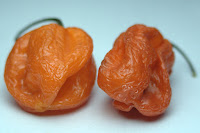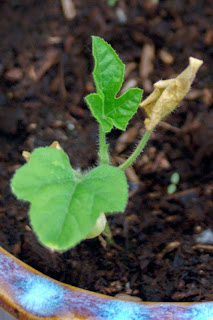I previously posted about some of the genetics involved in determining the color of tomatoes (
the-biologist-is-in.blogspot.com/2014/04/the-color-of-tomatoes.html). I've also written about the genetics of color in chile peppers (
the-biologist-is-in.blogspot.com/2015/05/the-color-of-peppers.html), but I recently decided the topic should be approached a second time. The following post is a much improved version of the original, with better photos (mostly my own) and a few more mutations being described.
Ripe
chile peppers (
Capsicum spp.) come in a very similar range of colors to ripe tomatoes.
Both vegetables (along with potatoes, tomatillos, and ground-cherries)
belong to the Solanaceae family of plants. Because of the close
relationship of the plants, there are strong similarities in how the
basic biology of color operates in each of them.
The
red color of a classic ripe tomato is due to lycopene. The red color of a
classic ripe pepper is not due to lycopene, but instead due to a
combination of Capsanthin and Capsorubin. These are produced by the
carotenoid pathway like lycopene, but they're produced further along the
pathway. The figure at right illustrates the carotenoid pathway in
peppers, to the degree I've been able to learn about it from reading
primary research literature. Most of the pathway here is identical to
that seen in tomatoes (and other plants), but with an extension after
Zeaxanthin.
Compared with tomatoes, there is less research available to elucidate
the genetics of color in pepper. The following figures are close-up versions of the main figure above,
highlighting the placement of a series of mutations in the pathway which
result in color changes. The mutations are
indicated by a large negative, highlighted in red, at
the location of the change to the pathway.
Carotenoid Mutations
 |
"Red", "orange", & "pale-orange"
mature habanero chiles. |
The first major color mutations are abbreviated as "
c1" and "
c2". Each mutation acts to reduce the levels of carotenoids produced in the ripe fruit. When both mutations are in the same plant, they interact to reduce pigment levels dramatically.
 |
| Mutant "c2". |
In the photo at left, the left-most chile is the typical wild-type red. The middle chile shows the orange caused by the presence of the "
c2" mutation. The right-most chile shows the pale-orange caused by the presence of both the "
c2" and "
c1" mutations.
The gene containing the "
c2" mutation has been identified as that of phytoene synthase (Psy). This defect at a very early stage in the carotenoid
pathway results in a strong suppression of every later product in the
pathway. (Mutations in the same gene in tomatoes are responsible for
the production of yellow or white fruit.) The "
c1" mutation has not been associated with a specific gene.
 |
| Mutant "y". |
The next major mutation (left) specifically knocks out the intense red Capsanthin and Capsorubin pigments of chiles. The mutant is abbreviated as "
y" because the resulting fruit are yellow when compared to the wild-type red color.
 |
"Red" & "yellow"
mature habanero chiles. |
To get the lovely lemon-yellow chile at right, the plant also needs to carry the "
c2" mutation described in the previous section. The "
y" mutation alone results in fruit with a orangish-yellow color (though I have not yet seen a chile I could be sure had this genotype). The variations of how different authors called colors as yellow or orange has led to different papers using the same color terms to refer to the colors produced by different combinations of genes. This can make it difficult to sort out how the results in one paper relate to those from another.
| y | c1 | c2 | | ripe-fruit-color |
| + | + | + | red |
| + | c1 | + | pale-red |
| + | + | c2 | orange |
| + | c1 | c2 | pale-orange |
| y | + | + | yellow-orange |
| y | c1 | + | pale-yellow |
| y | + | c2 | lemon-yellow |
| y | c1 | c2 | "white" |
These three mutations, in various combinations can produce anything from a rich "red" fruit to one that is as close to "white" as peppers get. At the left I've tried to represent the colors that would be produced by each genetic combination. I haven't seen some of the combinations, so the colors for those are more of my theory of what they would look like based on the descriptions in all the research I've read.
 |
| Mutant "bc". |
A complication to this story is that there are other mutations which produce a fruit that ripens to orange. The "
bc" mutation
interferes with the
conversion of β-carotene into β-cryptoxanthin, thus resulting in increased β-carotene and an orange color. The mutated gene has been identified as β-carotene hydroxylase 2 (Bch2)
There's a pair of other mutations, called "
B" and "
t", that also result in a high level of β-carotene. These two mutations are described as complementing, but it isn't entirely clear what genes they're involved in.
I can't find photos for strains with these last three mutations, but I'm assuming they're more orange than red or yellow due to the enhanced level of β-carotene. Part of the problem is that there isn't a central repository for mutant lines of chiles, so many lines are not generally available. (
The Chile Pepper Institute is supposedly working to resolve this by collecting strains discussed in research.)
 |
| Mutant "cl". |
Chlorophyll Mutations
The chlorophyll that makes an
immature pepper green is typically broken down during maturation of the fruit, revealing the bright red color of the ripe fruit. A
mutation "
cl" interferes with this breakdown and is therefore called "chlorophyll retainer". When the chlorophyll doesn't break down, darker colors result.
In an otherwise red pepper, the result is a
chocolate-brown color. In an otherwise
yellow pepper, the result is a ripe pepper with an
olive-green color. I'm not going to try simulating the colors we would expect for all the combinations of mutations, but I imagine an otherwise orange pepper would be an interesting shade in between brown and green.
I don't have any seed lines carrying this mutation, so I had to look to the web for illustrative photos. (
www.semillas.de has lots of interesting chiles, but ordering from them would be problematic for me due to being in a different country.)
 |
"Green" & "light-green"
immature habanero chiles. |
About the chlorophyll I just mentioned? There are mutations impacting the amount of it produced in immature fruits. In particular, an
alleleic series has been identified which results in immature chiles ranging from the typical medium-green all the way to a sulfury-white color. It isn't clear how many distinct alleles are around, leading to them being called "
sw" with various subscript labels (like "
sw1", "
sw2", ..., "
swn") to indicate the specific alleles.
 |
"Green" & "light-green"
habanero chiles, now mature. |
There's no way to know what the proper names for the alleles I have examples of are. They're both lighter than the wild-type color seen on other chiles and at best I can call them "
sw1" (for the darker) and "
sw2" (for the lighter) until I get some further examples of the series. These two chiles matured to an orange shade intermediate between the "red" and "orange" chiles I described earlier.
The lighter green color of the chiles indicates a reduction in the amount of chloroplasts. During ripening, the chloroplasts develop into chromoplasts as chlorophyll is degraded and carotenoids are synthesized. Fewer chloroplasts when immature means less chromoplasts when mature, thus a lighter "red" color. This phenomenon, where one gene impacts two or more seemingly unrelated traits, is called
pleiotropy. (The darker green chile maturing to the lighter orange says that things are complicated and there may be other mutations involved. I hope to sort it out over the next several years.)
Anthocyanin Mutations
 |
"Red" & "yellow", above.
"Pimenta da Neyde", below. |
There
are several pepper varieties that have purple or black immature fruit.
This trait is driven by two genes. The "
A" mutation allows
the plant to produce purple anthocyanin pigments in its leaves, stems, and immature fruit. The "
MoA" mutation modifies the effect of "
A" to increase the amount of anthocyanins produced, resulting in more of a
black color.
These anthocyanins are typically broken down as the fruit
matures and so even black immature chiles will ripen to red/yellow/etc. A very rare trait which interferes with this breakdown is seen in the variety
"Pimenta da Neyde". This trait results in mature fruit which remain purple or black. I haven't been able to
find any publications describing this trait, so I've decided to refer
to it as anthocyanin-retainer. I've found some of illustrative images of the the fruit produced in F1 plants: ("Pimenta da Neyde" x
"Bubblegum 7" ->
"Neyde x Bubblegum 7"), ("Pimenta da Neyde" x
"Trinidad Douglah" ->
"Douglah x Neyde"). These photos indicate the anthocyanin-retainer mutation is recessive, so the short-hand label for the trait should be the lower-case "
an". (I would only have to prove this pattern and write it up in a proper research publication to make the label official.)
Pattern Mutations
There are a several mutations ("
pi", "
bv", "
m-1", "
m-2", "
m-3", "
m-4", "
vgm", "
vgv", "
chl", "
dvg")
which result in various forms of variegation of chile plants/fruit. Unfortunately, I haven't heard of any of these mutations being associated with any available strain.
The oldest variety of a striped chile that I've come across is called
"Fish". The entire plant shows variegation and produces immature peppers with stripes of green and white. When the fruit matures, they change to the rich red color of typical peppers. I've read
anecdotes of the variegation trait in "Fish" spreading to other strains
when hybridized, which suggests dominance, but I haven't read any real
research about the genetic patterns of the trait in
"Fish" chiles.
Another type of striping is evident in a new variety called
"Enjoya" which is currently only available in the Netherlands. (
Anyone over there want to send me some seeds?) I managed to find one photo (
in this article) that shows the "Enjoya" plant and its immature fruit, which show no variegation. Stripes that appear only during fruit maturation does not match any mutation I can find descriptions for.
Another type of striping is seen in a series of pepper varieties still undergoing development. The first I came across is the iconic
"Pink Tiger" which was derived from a cross between
"Pimenta da Neyde" and
"Bhut Jolokia". All of this group (
"Pink Tiger";
"Pimenta Tiger";
"Black Scorpion Tongue"; others?) seem to be derived from crosses with "Pimenta da Neyde". This form of striping appears more random than the previous two. The peppers almost look like they have purple tears on the pale skin of the fruit. This trait also isn't associated with variegation in the rest of the plant. The extent of stripes/spots a plant produces seems to depend on how the plant was grown, though details of what conditions encourage or discourage the trait remain unclear to me.
References

















